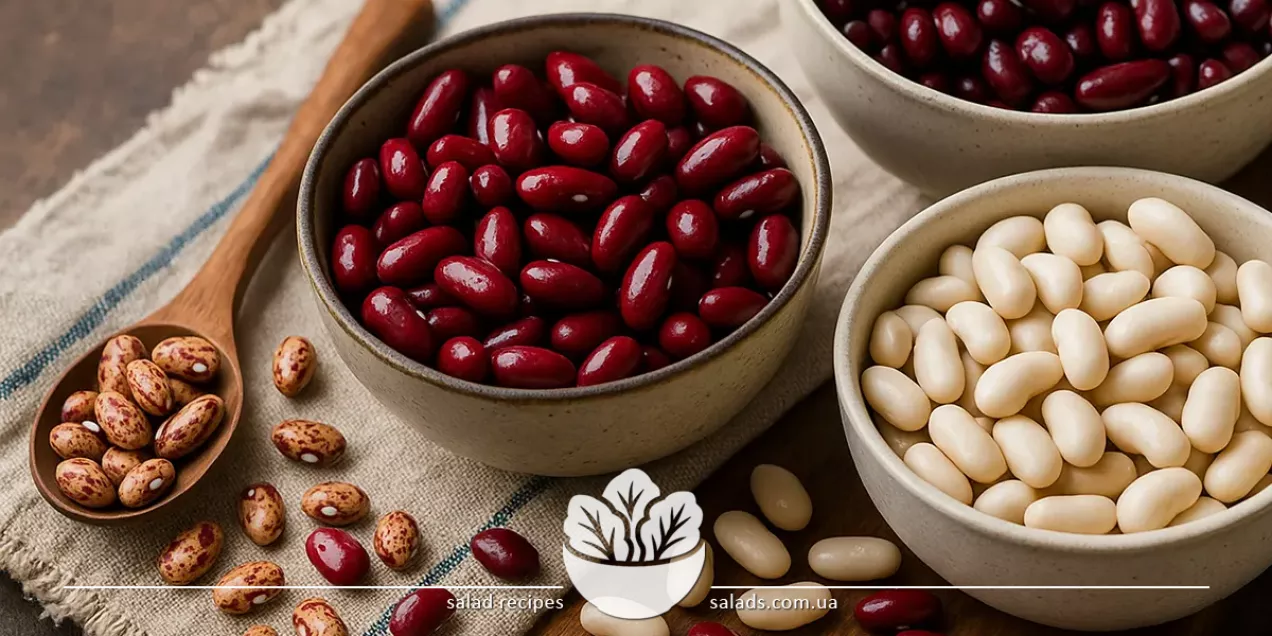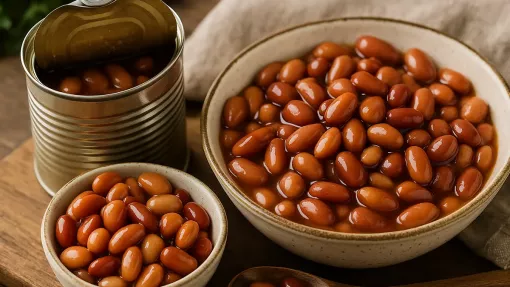Beans

Beans are among the most popular legumes, known for their high protein and fiber content and mild nutty flavor. In cooking, they are used boiled, stewed, fried, or canned. Beans are added to soups, vegetable stews, meat dishes, salads, pasta, and casseroles. They go well with spices, herbs, and other vegetables. Learn more about accompanying vegetables in the vegetables category.
Different Types of Beans
Red, White, Speckled: Popular Varieties of Beans
Red beans are one of the most well-known types. They have a firm texture, deep color, and rich flavor, making them ideal for stews, soups, and appetizers. This variety holds its shape well during cooking and is especially popular in Mexican, Caucasian, and Latin American cuisines. It is commonly used in chili con carne, borscht, vegetable mixes, and salads. White beans have a softer texture, a more delicate flavor, and break down more easily when cooked. That makes them ideal for puréed soups, stewed dishes, spreads, or as filling for baked goods. They are added to tomato sauces, vegetable sautés, vegetarian dishes, and combined with rice, pasta, or eggs. They are easy to digest and a good source of complete protein.
Speckled beans (such as pinto or turtle beans) combine the features of red and white beans – they have an attractive appearance, balanced flavor, and versatile usage. They are added to soups, stews, vegetable mixes, and casseroles. This type of bean is often used in traditional dishes of the Americas, the Mediterranean, and the Caucasus. Beans pair especially well with tomatoes, particularly in hot dishes, sauces, and soups. Tomatoes add a tangy note and bright color, while beans contribute heartiness and depth of texture.
Green and Asparagus Beans: Fresh Green Options
Green beans are immature pods consumed whole. They have a tender texture, pleasant fresh aroma, and cook quickly. They are used in salads, side dishes, soups, casseroles, and as a standalone dish. Green beans can be fried, stewed, baked, or blanched. They are perfect for light diets and are a valuable source of fiber. Asparagus beans (also called yardlong or Chinese beans) have similar properties but are longer, thinner, and more delicate. This ingredient is often used in Asian cuisine – in woks, salads, and vegetable mixes with soy sauce, ginger, and garlic. They are cut into large pieces and stir-fried quickly to retain their crisp texture and vibrant color.
Green beans pair well with butter, sour cream, soft cheeses, and nuts. They are often served with fried breadcrumbs or nut toppings. They are also found in popular vegetable mixes served as a side dish with meat, fish, or on their own. A particularly harmonious pairing is beans with onions: sautéed or stewed onions add a sweet note that enhances the light crunch of green beans.
Beans in Soups, Stews, Salads, and Casseroles
Beans are an ideal base for hearty soups, nutritious stews, savory salads, and baked dishes. In soups, they are often combined with tomatoes, onions, spices, meat, or grains. Soups made with red or white beans are especially popular and may be either thick or puréed. These soups retain heat for a long time and have a rich flavor, even without meat. In stews, beans are often paired with vegetables – carrots, peppers, zucchini, and eggplant. They quickly absorb the flavors of spices and create a dense consistency. Beans are used in both vegetarian options and meat-based dishes – with beef, pork, or poultry. The final result is a hearty, filling, and satisfying meal.
Bean salads are a classic of healthy eating. They can be served cold or warm, with added vegetables, grains, tuna, boiled eggs, or cheese. Popular combinations include olive oil, garlic, lemon juice, or mustard dressings. Canned or boiled beans are commonly used in salads – they cook quickly and blend well with other ingredients. Bean casseroles are another popular way to use this ingredient. Beans are layered with vegetables or meat, combined with sauces (tomato, cream, or sour cream), cheese, and spices. Baked beans acquire a pleasant texture and retain their nutritional value. A great match for such dishes is the combination of beans and garlic – together they form a flavorful base suitable for most legume-based recipes.
Beans in World Cuisines: Tradition and Modernity
Beans are a key ingredient in the cuisines of many cultures. In Mexican cuisine, they are featured in almost every second dish – from refried beans to soups, burritos, enchiladas, and nachos. Red or black beans are often combined with rice, corn, tomatoes, and hot peppers. With the right spices, they develop a strong aroma and rich texture. In Georgian cuisine, the famous dish lobio consists of stewed red beans with spices, herbs, garlic, and walnuts. It is served warm or cold, either as a side or main dish. Beans are also added to pies, casseroles, soups, and salads.
In the Balkans, they are used in gravče tavče – baked beans with tomatoes, peppers, onions, and spices. In Italy – in minestrone, pasta e fagioli, and many stewed legume dishes with olive oil, rosemary, and vegetables. In the Middle East, beans appear in dishes like ful – legume purée with oil, lemon juice, and spices. In Brazil – in traditional feijoada, where black beans are combined with meat and sausages. One of the best companions for beans is sweet pepper – they are often found together in salads, vegetable stews, soups, and side dishes, creating a colorful, flavorful, and nutritious meal.
How to Choose, Store, and Prepare Beans
Dried beans should be whole, clean, and free of mold, insects, or foreign odors. The grains should be firm, smooth, and of uniform size. When choosing canned beans, check the label – ideally, the can contains only beans, water, and salt, with no sugar or preservatives. Green beans should be bright green, firm, and free from dark spots or limpness. Store dried beans in airtight containers in a cool, dark place – they can last up to a year. Before cooking, they should be sorted, rinsed, and soaked for 6-12 hours to reduce cooking time, improve texture, and lower oligosaccharide content that may cause bloating. Beans should be simmered over low heat without salt at the beginning to avoid tough skins. Canned beans should be rinsed of marinade before use, especially in salads. Green beans should be lightly blanched before adding to salads or stir-fried in wok dishes. Beans pair well with cabbage, especially in stews, soups, or vegetarian stuffed cabbage and pies. Together, they create a hearty and textured base that blends easily with other ingredients.
